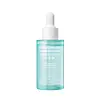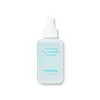What's inside
What's inside
 Key Ingredients
Key Ingredients

 Benefits
Benefits

 Concerns
Concerns

No concerns
 Ingredients Side-by-side
Ingredients Side-by-side

Water
Skin ConditioningButylene Glycol
HumectantGlycerin
HumectantDipropylene Glycol
HumectantPropanediol
Solvent1,2-Hexanediol
Skin ConditioningHydroxyethyl Urea
HumectantMethyl Gluceth-20
HumectantHydroxyacetophenone
AntioxidantArginine
MaskingCarbomer
Emulsion StabilisingHydrolyzed Hyaluronic Acid
HumectantAllantoin
Skin ConditioningPanthenol
Skin ConditioningSodium Hyaluronate
HumectantGlyceryl Acrylate/Acrylic Acid Copolymer
HumectantBeta-Glucan
Skin ConditioningEctoin
Skin ConditioningLinoleic Acid
CleansingMyristoyl/Palmitoyl Oxostearamide/Arachamide Mea
Skin ConditioningPhytosterols
Skin ConditioningSqualane
EmollientHouttuynia Cordata Extract
Skin ConditioningGlycine
BufferingGlutamic Acid
HumectantSodium Dna
Skin ConditioningWater, Butylene Glycol, Glycerin, Dipropylene Glycol, Propanediol, 1,2-Hexanediol, Hydroxyethyl Urea, Methyl Gluceth-20, Hydroxyacetophenone, Arginine, Carbomer, Hydrolyzed Hyaluronic Acid, Allantoin, Panthenol, Sodium Hyaluronate, Glyceryl Acrylate/Acrylic Acid Copolymer, Beta-Glucan, Ectoin, Linoleic Acid, Myristoyl/Palmitoyl Oxostearamide/Arachamide Mea, Phytosterols, Squalane, Houttuynia Cordata Extract, Glycine, Glutamic Acid, Sodium Dna
Aloe Barbadensis Leaf Polysaccharides
EmollientButylene Glycol
HumectantGlycerin
HumectantDipropylene Glycol
HumectantWater
Skin Conditioning1,2-Hexanediol
Skin ConditioningHydroxyacetophenone
AntioxidantAmmonium Acryloyldimethyltaurate/Vp Copolymer
Polyglycerin-3
HumectantPropanediol
SolventMalachite Extract
AntioxidantPolyglyceryl-10 Oleate
Skin ConditioningGlycosyl Trehalose
Emulsion StabilisingMethyl Gluceth-20
HumectantGlyceryl Acrylate/Acrylic Acid Copolymer
HumectantHydrogenated Starch Hydrolysate
HumectantSodium Hyaluronate
HumectantBiosaccharide Gum-1
HumectantAllantoin
Skin ConditioningBetaine
HumectantHydrolyzed Vegetable Protein
Skin ConditioningLinum Usitatissimum Seed Extract
PerfumingMaltodextrin
AbsorbentPanthenol
Skin ConditioningPentylene Glycol
Skin ConditioningTrehalose
HumectantHouttuynia Cordata Extract
Skin ConditioningEthylhexylglycerin
Skin ConditioningTocopherol
AntioxidantAloe Barbadensis Leaf Polysaccharides, Butylene Glycol, Glycerin, Dipropylene Glycol, Water, 1,2-Hexanediol, Hydroxyacetophenone, Ammonium Acryloyldimethyltaurate/Vp Copolymer, Polyglycerin-3, Propanediol, Malachite Extract, Polyglyceryl-10 Oleate, Glycosyl Trehalose, Methyl Gluceth-20, Glyceryl Acrylate/Acrylic Acid Copolymer, Hydrogenated Starch Hydrolysate, Sodium Hyaluronate, Biosaccharide Gum-1, Allantoin, Betaine, Hydrolyzed Vegetable Protein, Linum Usitatissimum Seed Extract, Maltodextrin, Panthenol, Pentylene Glycol, Trehalose, Houttuynia Cordata Extract, Ethylhexylglycerin, Tocopherol
Ingredients Explained
These ingredients are found in both products.
Ingredients higher up in an ingredient list are typically present in a larger amount.
1,2-Hexanediol is a synthetic liquid and another multi-functional powerhouse.
It is a:
- Humectant, drawing moisture into the skin
- Emollient, helping to soften skin
- Solvent, dispersing and stabilizing formulas
- Preservative booster, enhancing the antimicrobial activity of other preservatives
Allantoin is a soothing ingredient known for its protective and moisturizingg properties. Because of this, it is often added to products with strong active ingredients.
Studies show higher concentrations of this ingredient can promote wound healing.
Though it can be derived from the comfrey plant, allantoin is produced synthetically for cosmetic products to ensure purity.
Learn more about AllantoinButylene Glycol (or BG) is used within cosmetic products for a few different reasons:
Overall, Butylene Glycol is a safe and well-rounded ingredient that works well with other ingredients.
Though this ingredient works well with most skin types, some people with sensitive skin may experience a reaction such as allergic rashes, closed comedones, or itchiness.
Learn more about Butylene GlycolDipropylene Glycol is a synthetically created humectant, stabilizer, and solvent.
This ingredient helps:
Dipropylene glycol is technically an alcohol, but it belongs to the glycol family (often considered part of the ‘good’ alcohols). This means it is hydrating and gentle on skin unlike drying solvent alcohols like denatured alcohol.
As a masking agent, Dipropylene Glycol can be used to cover the smell of other ingredients. However, it does not have a scent.
Studies show Dipropylene Glycol is considered safe to use in skincare.
Learn more about Dipropylene GlycolGlycerin is already naturally found in your skin. It helps moisturize and protect your skin.
A study from 2016 found glycerin to be more effective as a humectant than AHAs and hyaluronic acid.
As a humectant, it helps the skin stay hydrated by pulling moisture to your skin. The low molecular weight of glycerin allows it to pull moisture into the deeper layers of your skin.
Hydrated skin improves your skin barrier; Your skin barrier helps protect against irritants and bacteria.
Glycerin has also been found to have antimicrobial and antiviral properties. Due to these properties, glycerin is often used in wound and burn treatments.
In cosmetics, glycerin is usually derived from plants such as soybean or palm. However, it can also be sourced from animals, such as tallow or animal fat.
This ingredient is organic, colorless, odorless, and non-toxic.
Glycerin is the name for this ingredient in American English. British English uses Glycerol/Glycerine.
Learn more about GlycerinGlyceryl Acrylate/Acrylic Acid Copolymer is made up of glycerin and polyacrylic acid. It helps hydrate your skin as a humectant.
This ingredient forms a hydrogel that delivers moisturizing, water-based ingredients to the skin. It is also used to thicken a product and to give it a smooth texture.
Acrylic acid itself is toxic, but the polymer form (this ingredient) is too large to penetrate skin, making it non-toxic.
Learn more about Glyceryl Acrylate/Acrylic Acid CopolymerHouttuynia Cordata Extract is more commonly known as Heart Leaf, Fish Mint, or Chameleon plant.
The components found in Heart Leaf give it antioxidant, hydrating, antimicrobial, and anti-inflammatory properties.
Heart Leaf is rich in flavonoids such as quercetin, apigenin, and more. It also contains polysaccharides, the most common type of carbs in food.
Flavonoids have been shown to be effective antioxidants. They help neutralize free-radical molecules. Free-radical molecules are unstable molecules that may damage our skin cells and DNA. The flavonoids in Heart Leaf also help soothe the skin.
Polysaccharides are naturally found in our skin. They play a role in hydrating and repairing the top layer of skin. The polysaccharides in Heart Leaf help moisturize our skin.
Studies show decanoyl acetaldehyde, a component of Heart Leaf oil, is effective at killing bacteria.
The name 'Fish Mint' comes from the herb's natural fishy smell. Is is native to southeast Asia and used throughout the continent for traditional cooking and medicine.
Learn more about Houttuynia Cordata ExtractHydroxyacetophenone is antioxidant with skin conditioning and soothing properties. It also boosts the efficiency of preservatives.
This ingredient is not irritating or sensitizing.
Methyl Gluceth-20 is a humectant. Humectants help draw moisture from the air to your skin.
It is created by combining polyethylene glycol with glucose.
Panthenol is a common ingredient that helps hydrate and soothe the skin. It is found naturally in our skin and hair.
There are two forms of panthenol: D and L.
D-panthenol is also known as dexpanthenol. Most cosmetics use dexpanthenol or a mixture of D and L-panthenol.
Panthenol is famous due to its ability to go deeper into the skin's layers. Using this ingredient has numerous pros (and no cons):
Like hyaluronic acid, panthenol is a humectant. Humectants are able to bind and hold large amounts of water to keep skin hydrated.
This ingredient works well for wound healing. It works by increasing tissue in the wound and helps close open wounds.
Once oxidized, panthenol converts to pantothenic acid. Panthothenic acid is found in all living cells.
This ingredient is also referred to as pro-vitamin B5.
Learn more about PanthenolPropanediol is an all-star ingredient. It softens, hydrates, and smooths the skin.
It’s often used to:
Propanediol is not likely to cause sensitivity and considered safe to use. It is derived from corn or petroleum with a clear color and no scent.
Learn more about PropanediolSodium Hyaluronate is hyaluronic acid's salt form. It is commonly derived from the sodium salt of hyaluronic acid.
Like hyaluronic acid, it is great at holding water and acts as a humectant. This makes it a great skin hydrating ingredient.
Sodium Hyaluronate is naturally occurring in our bodies and is mostly found in eye fluid and joints.
These are some other common types of Hyaluronic Acid:
Learn more about Sodium HyaluronateWater. It's the most common cosmetic ingredient of all. You'll usually see it at the top of ingredient lists, meaning that it makes up the largest part of the product.
So why is it so popular? Water most often acts as a solvent - this means that it helps dissolve other ingredients into the formulation.
You'll also recognize water as that liquid we all need to stay alive. If you see this, drink a glass of water. Stay hydrated!
Learn more about Water